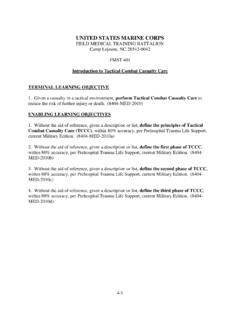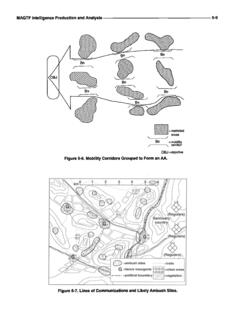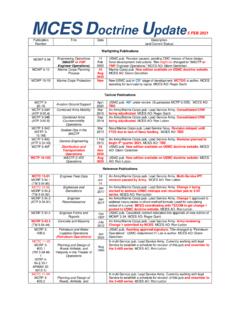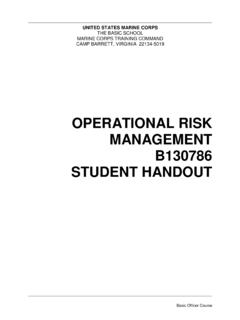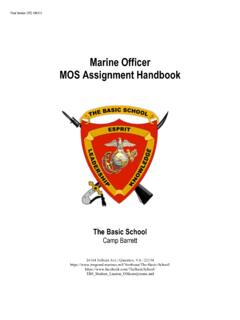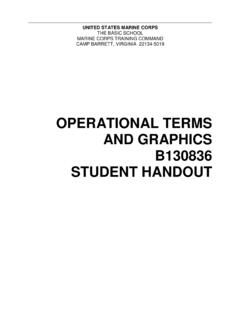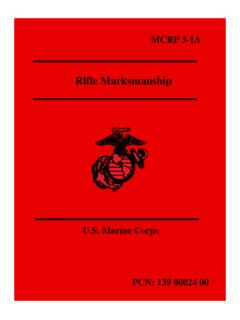Transcription of SYSTEMS APPROACH TO TRAINING (SAT) MANUAL JUNE …
1 SYSTEMS APPROACH TO TRAINING . (SAT) MANUAL . JUNE 2004. SUGGESTION FORM. From: Subj: RECOMMENDATION FOR IMPROVEMENT TO THE SAT MANUAL . 1. In accordance with the Forward to the SYSTEMS APPROACH to TRAINING (SAT) MANUAL , which encourages commands to provide suggestions for improving the publication; the following unclassified recommendation is submitted: _____ _____ _____ _____. Page Para. No. Line No. Figure/Appendix Nature of Change: ___Add ___Delete ___Change___Correct 2. Proposed New Text: (Verbatim, double-spaced; continue on additional pages, if necessary.). 3. Justification/Rationale/Impact of Proposed Change: (Include source; may be single spaced.). PREFACE. The SYSTEMS APPROACH to TRAINING (SAT) MANUAL was developed to support Marine Corps TRAINING /education policy and Department of Defense (DoD) military TRAINING program requirements.
2 This MANUAL serves as a primary source of information and guidance, mainly for use by the formal school/ TRAINING centers'. instructional staff, for instructional program development and management. The SAT MANUAL is divided into five chapters, each chapter corresponding to a phase within the SAT model: Analyze, Design, Develop, Implement, and Evaluate. In many of the sections within each chapter, topic material is presented first, followed by procedural steps for performing a task or function. Throughout the MANUAL , hypothetical examples are provided to illustrate a concept, topic, or procedure. While the information contained in the SAT MANUAL is based on and derived from accepted adult learning theories and current instructional development practices, the MANUAL is designed as an introduction to these topics.
3 Additional research in education-related fields is recommended for those personnel who participate in the development or management of instruction. i EXECUTIVE SUMMARY. Overview. The mission of any instructional system is to determine instructional needs and priorities, develop effective and efficient solutions to achieving these needs, implement these solutions in a competent manner, and assess the degree to which the outcomes of the system meet the specified needs. To achieve this in the most effective way possible, a SYSTEMS APPROACH to the process and procedures of instruction was developed. The resulting model, entitled Instructional SYSTEMS Design (ISD), was later adopted by the Marine Corps as the SYSTEMS APPROACH to TRAINING (SAT). The model, whether it is referred to as ISD or SAT, is a recognized standard governing the instructional process in the private sector and within the Department of Defense (DoD).
4 Goal of Instruction The goal of Marine Corps instruction is to develop performance-based, criterion-referenced instruction that promotes student transfer of learning from the instructional setting to the job. For a learning outcome to be achieved, instruction must be effective and efficient. Instruction is effective when it teaches learning objectives based on job performance requirements and efficient when it makes the best use of resources. SAT is a comprehensive process that identifies what is performed on the job, what should be instructed, and how this instruction should be developed and conducted. This systematic APPROACH ensures that what is being instructed are those tasks that are most critical to successful job performance. It also ensures that the instructional APPROACH chosen is the most time and cost efficient.
5 The SAT process further identifies standards of performance and learning objectives. This ensures that students are evaluated on their ability to meet these objectives and that instructional courses are evaluated based on whether or not they allow student mastery of these objectives. Finally, the SAT identifies needed revisions to instruction and allows these revisions to be made to improve instructional program effectiveness and efficiency. ii Intent of SAT. The SAT was created to manage the instructional process for analyzing, designing, developing, implementing, and evaluating instruction. The SAT serves as a blueprint for organizing or structuring the instructional process. The SAT is a set of comprehensive guidelines, tools, and techniques needed to close the gap between current and desired job performance through instructional intervention.
6 The Marine Corps originally targeted the SAT for use in formal schools, but the comprehensive system applies to unit/field TRAINING as well as to education. The SAT is a flexible, outcome-oriented system based on the requirements defined by education and TRAINING . Whether referred to as education or TRAINING , the instructional process is the same; it is the outcomes that are different. Therefore, in keeping with the intention of the SAT model, throughout this SAT MANUAL , the term instruction will be used to discuss both TRAINING and education. Benefits of SAT. The SYSTEMS APPROACH to TRAINING is a dynamic, flexible system for developing and implementing effective and efficient instruction to meet current and projected needs. The SAT. process is flexible in that it accounts for individual differences in ability, rate of learning, motivation, and achievement to capitalize on the opportunity for increasing the effectiveness and efficiency of instruction.
7 The SAT process reduces the number of school management decisions that have to be made subjectively and, instead, allows decisions to be made based on reasonable conclusions which are based on carefully collected and analyzed data. More than one solution to an instructional problem may be identified through the SAT, however the selection of the best solution is a goal of SAT. The SAT is a continuous, cyclical process allowing any one of the five phases, and their associated functions, to occur at any time. In addition, each phase within SAT further builds upon the previous phase, providing a system of checks and balances to insure all instructional data are accounted for and that revisions to instructional materials are identified and made. iii It is not the intent of the SAT process to create an excessive amount of paperwork, forms, and reporting requirements that must be generated by each formal school/ TRAINING center conducting instruction.
8 This would serve only to detract from the instructional program. The SAT process does not provide a specific procedure for every instructional situation that can be encountered. Instead, it presents a generalized APPROACH that can be adapted to any instructional situation. SAT Phases. The SAT model simplifies and standardizes the instructional process into manageable subsets. The SAT process is made up of five distinct phases, each serving a specific purpose. The five phases are Analyze, Design, Develop, Implement, and Evaluate. Each of these phases involves inputs, a process, and outputs. The successive phases of the SAT build upon the outcomes of the previous phase(s). 1. Analyze. During the Analyze Phase of SAT, a particular job or Occupational Field/Military Occupational Specialty (OccFld/MOS) is analyzed by Marine Corps Combat Development Command (MCCDC, C 461) to determine what job holders perform on the job, the order in which they perform it, and the standard of performance necessary to adequately perform the job.
9 The result, or outcome, of the Analyze Phase is Individual TRAINING Standards (ITS) selected for instruction. ITSs are behavior statements that define job performance in the Marine Corps and serve as the basis for all Marine Corps instruction. The elements of the Analyze Phase are: Job Analysis. Job or occupational analysis is performed to determine what the job holder must know or do on the job. Job analysis results in a verified list of all duties and tasks performed on the job. Task Analysis. Task analysis (sometimes called TRAINING Analysis) is performed to determine the job performance requirements requisite of each task performed on the job. Job performance requirements include a task statement, conditions, standard, performance steps, administrative instructions, and references.
10 Job performance requirements in the Marine Corps are defined by Individual TRAINING Standards (ITSs). ITSs define the measures of performance that are to be used in diagnosing individual performance and evaluation of instruction. iv Selection of Tasks for Instruction. Current instructional needs are determined by selecting tasks for instruction. Tasks are selected based on data collected concerning several criteria relating to each task. A by-product of this process is the determination of the organization responsible for conducting the instruction and the instructional setting assigned to each task. Input Process Outcome Job task Job analysis Task List data Task analysis Individual TRAINING Standards (ITS). Instructional Setting 2. Design. During the Design Phase of SAT, formal school/ TRAINING center instructional developers equate task performance under job conditions (ITSS) to task performance within the instructional setting (learning objectives).
